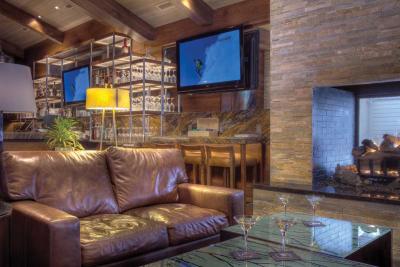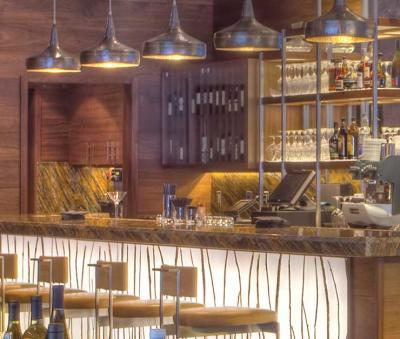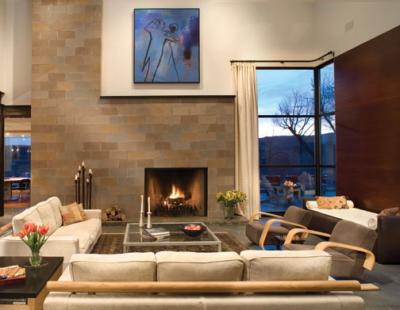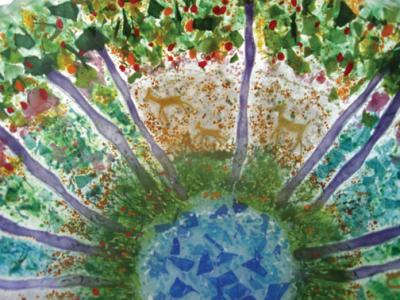Yampa Living
04/01/2009 01:00AM ● By Dagny McKinley
Spring-Summer 2009:
Yampa Living
by Dagny McKinley
Mountain ModernFrom St.Cloud to Trailhead, nedesign creates enticing interiors The St.Cloud Mountain Club uses natural materials in their rastate, from stacked slate walls to walnut wood panels, and blends it with warm-fabric furniture. Photo courtesy of Ken Lee Move over mountain rustic and other interior design motifs. There’s a nesheriff in town when it comes to design. Mountain modern, a blend of rustic mountain charm with modern amenities, is making waves in Routt County. “It combines rustic elements like log furniture but uses clean lines and modern designs,” says Sara Shalls, an interior designer forThe Ranch House, which decorated Resort Ventures West’s Trailhead Lodge near the ski area’s base. “We looked to the Steamboat environment for inspiration, including the ranching and ski heritage and landscape.” Matching the landscape is an open floor plan where contemporary lines blend with traditional furniture and metal accents. The rooms’ use of granite, slate, travertine and iron create focal points, offset by the clean straight lines of wood and timber, from flooring and countertops to beams overhead. Straight-edged furniture and leather couches enhance the feel, as do flat screen TVs above natural stone fireplace mantles and the liberal use of floor-to-ceiling windows that open onto expansive decks.
The St.Cloud Mountain Club uses natural materials in their rastate, from stacked slate walls to walnut wood panels, and blends it with warm-fabric furniture. Photo courtesy of Ken Lee Move over mountain rustic and other interior design motifs. There’s a nesheriff in town when it comes to design. Mountain modern, a blend of rustic mountain charm with modern amenities, is making waves in Routt County. “It combines rustic elements like log furniture but uses clean lines and modern designs,” says Sara Shalls, an interior designer forThe Ranch House, which decorated Resort Ventures West’s Trailhead Lodge near the ski area’s base. “We looked to the Steamboat environment for inspiration, including the ranching and ski heritage and landscape.” Matching the landscape is an open floor plan where contemporary lines blend with traditional furniture and metal accents. The rooms’ use of granite, slate, travertine and iron create focal points, offset by the clean straight lines of wood and timber, from flooring and countertops to beams overhead. Straight-edged furniture and leather couches enhance the feel, as do flat screen TVs above natural stone fireplace mantles and the liberal use of floor-to-ceiling windows that open onto expansive decks.  Hammered copper drop-down lights over the bar are one of the club's many highlights Exploring its own ways to create mountain modern ambiance, the St. Cloud Mountain Club, also at the mountain’s base, turned to San Francisco’s Hirsch Bedner and Associates. The use of natural materials in their rastate, playing stacked slate walls off walnut wood panels, creates a harmonious fusion that pairs with warm-fabric furniture, including leather chairs with squared-off edges and rectangular benches with leather toppings. The club also employs hammered copper for drop-down lights over the bar, as well as art pieces that blend with the interior’s materials. For the latter, the club employed long-time Steamboat Springs artist Eileen Braziel for a projection piece featuring an oil-on-canvas painting of a phoenix wing with a hologram of a moving wing. The effect is one of doves fluttering up the wall.
Hammered copper drop-down lights over the bar are one of the club's many highlights Exploring its own ways to create mountain modern ambiance, the St. Cloud Mountain Club, also at the mountain’s base, turned to San Francisco’s Hirsch Bedner and Associates. The use of natural materials in their rastate, playing stacked slate walls off walnut wood panels, creates a harmonious fusion that pairs with warm-fabric furniture, including leather chairs with squared-off edges and rectangular benches with leather toppings. The club also employs hammered copper for drop-down lights over the bar, as well as art pieces that blend with the interior’s materials. For the latter, the club employed long-time Steamboat Springs artist Eileen Braziel for a projection piece featuring an oil-on-canvas painting of a phoenix wing with a hologram of a moving wing. The effect is one of doves fluttering up the wall.Bringing the Outside In Massive boulders in the basement. Hydroponic greenhouses in thekitchen. Grass growing on roofs. Waterfalls in the living room. For the most part, homes are designed to keep the outside out. But one trendsweeping through Steamboat Springs is helping to bring the outside in. The practice of "ecomimesis" defined as "the theoretical link between the evolution of species and the adaptive/climate-responsive architecture" is helping local residents embrace the beauty of the outdoors in their homes. "There's a lot you can do, from working with light tomaterials, to bring the great outdoors inside your great room," says Michael J.K. Olsen of Michael Olsen Architects. Large windows and rolling glass doors open Kevin and Nancy Ventrudo's home to the Elk Valley's classic views. Photo by www.davidpattersonphotography.com No one knows this more than Kevin and Nancy Ventrudo, whose home on County Road 42 has an outdoor fireplace on the deck that backs up to the indoor one, an eight-foot-high rolling glass door off the living room that opens up to the same deck above the Elk River, and expansive views of everything from Hahn's Peak, Sleeping Giant and the Flat Tops to Mount Werner. "We feel likewe're part of the landscape," says Kevin of the home designed by West Elevation Architects. "The glass door becomes a moveable wall, and our dining room, kitchen and living area all flotogether access the deck, which is a true outdoor living space. We're out there all the time." The key to their home is harnessing natural light, which blurs the distinction between outdoors and in. Glass panels and even glazed ceiling panels can all replicate the mood of the sky. "Using light creates houses that respond to the environment," says Habitat Construction's Mike Roberts, adding that rock is also part of the trend. In building his Sanctuary home, when his creencountered an unmovable boulder, he cut steps into it and created a wine room around it in his basement. Other applications include using river rock for fireplaces and even utilizing pebbles to massage feet in showers. Another technique is heralding a material's natural look and properties, whether it's stone, steel or plaster. "It's all about emphasizing the beauty of the materials," says Tim Stone of KSaArchitecture, adding that you can also utilize the planes of natural materials, from wood ceilings to stone walls and glass separations. "Marrying timber, stone and steel can create a perfect harmony between inside and out." He adds that you can also use still-living wood to bring the outside in, pointing to one home he designed that has a ponderosa pine as its centerpiece, with an escape outside for the branches.You can even grogardens on your roof. "Vegetative roofs bring the ground up to the second level," says Jeff Gerber of Robert Hawkins Architect. "They connect with the landscape and break up what would otherwise be a long view." They also control storm water run-off and help water conservation. Water, itself, can also be used to create ambiance, adding both a visual and auditory element to a home. It can also provide humidity and even habitat, as in the case of aquariums. Others use greenhouses to achieve the outdoors-in effect. "There are a lot of benefits to having greenhouses attached to your house," says Lisa Benjamin of Evo Design, who's working on one project with owners who plan to grobananas, pomegranates and other tropical fare for personal use and to supply local health food stores. Whether it's plants, materials, glass, water, boulders, dual-environment decksor roofs you have to mow, bringing the outside in means you're never far from the natural world. "Houses, like people, respond to changes in weather and climate," Mike Roberts says. "They can capture and emphasize the outside world and affect the way a person lives."
Large windows and rolling glass doors open Kevin and Nancy Ventrudo's home to the Elk Valley's classic views. Photo by www.davidpattersonphotography.com No one knows this more than Kevin and Nancy Ventrudo, whose home on County Road 42 has an outdoor fireplace on the deck that backs up to the indoor one, an eight-foot-high rolling glass door off the living room that opens up to the same deck above the Elk River, and expansive views of everything from Hahn's Peak, Sleeping Giant and the Flat Tops to Mount Werner. "We feel likewe're part of the landscape," says Kevin of the home designed by West Elevation Architects. "The glass door becomes a moveable wall, and our dining room, kitchen and living area all flotogether access the deck, which is a true outdoor living space. We're out there all the time." The key to their home is harnessing natural light, which blurs the distinction between outdoors and in. Glass panels and even glazed ceiling panels can all replicate the mood of the sky. "Using light creates houses that respond to the environment," says Habitat Construction's Mike Roberts, adding that rock is also part of the trend. In building his Sanctuary home, when his creencountered an unmovable boulder, he cut steps into it and created a wine room around it in his basement. Other applications include using river rock for fireplaces and even utilizing pebbles to massage feet in showers. Another technique is heralding a material's natural look and properties, whether it's stone, steel or plaster. "It's all about emphasizing the beauty of the materials," says Tim Stone of KSaArchitecture, adding that you can also utilize the planes of natural materials, from wood ceilings to stone walls and glass separations. "Marrying timber, stone and steel can create a perfect harmony between inside and out." He adds that you can also use still-living wood to bring the outside in, pointing to one home he designed that has a ponderosa pine as its centerpiece, with an escape outside for the branches.You can even grogardens on your roof. "Vegetative roofs bring the ground up to the second level," says Jeff Gerber of Robert Hawkins Architect. "They connect with the landscape and break up what would otherwise be a long view." They also control storm water run-off and help water conservation. Water, itself, can also be used to create ambiance, adding both a visual and auditory element to a home. It can also provide humidity and even habitat, as in the case of aquariums. Others use greenhouses to achieve the outdoors-in effect. "There are a lot of benefits to having greenhouses attached to your house," says Lisa Benjamin of Evo Design, who's working on one project with owners who plan to grobananas, pomegranates and other tropical fare for personal use and to supply local health food stores. Whether it's plants, materials, glass, water, boulders, dual-environment decksor roofs you have to mow, bringing the outside in means you're never far from the natural world. "Houses, like people, respond to changes in weather and climate," Mike Roberts says. "They can capture and emphasize the outside world and affect the way a person lives."
A Glas Act - Using stained and other glass to highlight your home Working with stained glass dates back to the Egyptians, who were staining and shaping glass into beads as far back as 2750 BC. Something about the process has drawn artists ever since, and the craft can increasingly be found in homes in the Yampa Valley. Whether it's used in windows, cabinets, doors or even lamps, stained glass can addan uncommon element to a home, with themes including everything from nature and abstract art to skiers schussing down Mount Werner. Creating it combines artistry and engineering. A windomustfit certain measurements and be strong enough to stand up to wind, rain and storms, all while using light to illuminate a design. Robin Clow's intricate wildlife scene shows multiple types of glass used in her "Harvest Moon" bowl. But it's the pattern that makes the piece. "I prefer using pieces of glass that are visually interesting and stimulate the imagination," says Paul Rutledge, who founded NeVictoria Stained Glass in 1985. He cites one mountainscape adorning a local home where he studied theglass for days before creating the desired effect. He employed similar scrutinizing for another, entitled "The Jewel of the Yampa," which records the Stagecoach valley before it was flooded. "I like to play off its features," says Paul, whose works can be found throughout Routt County, especially in cabinets. "I like to make pieces that are an artistic journey and mean different things to different people." Georgian Kaloof By George throws a different light on the craft. After 35 years of working with glass, Georgian nobuilds lamps that incorporate Brazilian agate and other minerals. Sheshops for translucent rocks, and then builds lamps around them. She also works with glass sheets, with her husband serving as technical advisor for all animalscapes, including a moose windonowresiding in a Yampa Valley home. Robin Cloof Ullr Designs used to do commissioned stained glass projects and nofocuses on kiln-formed glass fusing different pieces of glass together to create patterns and shapes. Her creations, which grace homes in Steamboat, Telluride and Denver, include bowls, dishes and panelsthat require up to six kiln firings each. As well as adding ambiance to a home, creating them also makes her own life full. "I can see myself as an old woman with a stand in my driveway selling glass bowls," she says. "That's homuch I love it."
Robin Clow's intricate wildlife scene shows multiple types of glass used in her "Harvest Moon" bowl. But it's the pattern that makes the piece. "I prefer using pieces of glass that are visually interesting and stimulate the imagination," says Paul Rutledge, who founded NeVictoria Stained Glass in 1985. He cites one mountainscape adorning a local home where he studied theglass for days before creating the desired effect. He employed similar scrutinizing for another, entitled "The Jewel of the Yampa," which records the Stagecoach valley before it was flooded. "I like to play off its features," says Paul, whose works can be found throughout Routt County, especially in cabinets. "I like to make pieces that are an artistic journey and mean different things to different people." Georgian Kaloof By George throws a different light on the craft. After 35 years of working with glass, Georgian nobuilds lamps that incorporate Brazilian agate and other minerals. Sheshops for translucent rocks, and then builds lamps around them. She also works with glass sheets, with her husband serving as technical advisor for all animalscapes, including a moose windonowresiding in a Yampa Valley home. Robin Cloof Ullr Designs used to do commissioned stained glass projects and nofocuses on kiln-formed glass fusing different pieces of glass together to create patterns and shapes. Her creations, which grace homes in Steamboat, Telluride and Denver, include bowls, dishes and panelsthat require up to six kiln firings each. As well as adding ambiance to a home, creating them also makes her own life full. "I can see myself as an old woman with a stand in my driveway selling glass bowls," she says. "That's homuch I love it."




